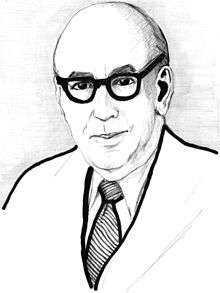C. Miller Fisher
Charles Miller Fisher, usually known as C. Miller Fisher (December 5, 1913, Waterloo, Ontario – April 14, 2012, Albany, New York) was a Canadian neurologist whose notable contributions include the first detailed descriptions of lacunar strokes, the identification of transient ischemic attacks as stroke precursors, the identification of the link between carotid atherosclerosis and stroke, and the description of a variant form of Guillain–Barré syndrome which bears his name.[1][2]

Education and career
Fisher received a B.A. from Victoria University in Toronto in 1935. He then attended the University of Toronto Medical School, where he received his M.D. in 1938. He continued training at Henry Ford Hospital in Detroit and Royal Victoria Hospital in Montreal.[3]
During World War II, Fisher served as a surgical lieutenant in the Royal Canadian Navy, and was aboard HMS Voltaire when it was sunk by German gunfire in 1941 off the coast of Cape Verde. Fisher was captured and spent 3.5 years in a German prison camp, until late 1944 when he was released.[4]
Following his return to Canada, Fisher began his residency at McGill University at the Royal Victoria Hospital. In 1946 he worked as a Fellow at the Montreal Neurological Institute of McGill University.[3] He then began working at Massachusetts General Hospital on the stroke service, beginning a long career in stroke neurology.[5]
Contributions
Fisher is credited with describing the clinical syndrome of the transient ischemic attack ("mini-stroke").[1] Fisher proved, by a series of pathological studies, the relationship between stroke and the formation of blood clots in the heart in patients with atrial fibrillation. He also showed the relationship between stroke and carotid artery stenosis, which made preventive surgery possible and greatly reduced the incidence of subsequent strokes.[1] He was a founder of Massachusetts General Hospital Stroke Service.[6] He contributed greatly towards the current use of anticoagulants for stroke prevention in atrial fibrillation.[5]
He contributed greatly to the understanding of stroke, more specifically carotid artery disease[1][5] and lacunar infarcts and their syndromes. With regard to the lacunar syndromes he described the concept,[7] the "pure motor stroke",[8] the "pure sensory stroke",[9] and the mechanism underlying the different stroke syndromes.[10][11][12]
He made a number of contributions to the understanding of cervical artery dissection (carotid artery dissection and vertebral artery dissection) in the 1970s,[5] and that of subarachnoid hemorrhage due to cerebral aneurysms.[5]
In 1956 he reported a variant of Guillain–Barré syndrome, nowadays known as Miller Fisher Syndrome.[13]
"Fisher test" is also used to describe the CSF tap test which may be required in the diagnosis of normal pressure hydrocephalus.[14]
Personal life
C. Miller Fisher was married to Doris M. Fisher for 68 years until her death in 2008. He had two sons and one daughter.[2]
Awards and honors
In 1952 he was the recipient of the Royal College of Physicians of Canada's Prize in Medicine, and in 1998 he entered the Canadian Medical Hall of Fame.[1]
Death
Fisher died April 14, 2012 in St. Peter's Nursing & Rehabilitation Center in Albany, New York. He was 98 years old.[15]
References
- Estol CJ (March 1996). "Dr C. Miller Fisher and the history of carotid artery disease". Stroke. 27 (3): 559–66. doi:10.1161/01.str.27.3.559. PMID 8610329.
- "HMS Professor C. Miller Fisher Dies at 98 | News | The Harvard Crimson". Thecrimson.com. 1913-12-05. Retrieved 2012-05-04.
- "Fisher, C. Miller, MD". Archived from the original on 4 March 2016. Retrieved 11 September 2014.
- J.P. Mohr, MD, MS; Louis R. Caplan, MD; J. Philip Kistler, MD (Jul 1, 2012). "C. Miller Fisher: An Appreciation". Stroke. 43 (7): 1739–1740. doi:10.1161/STROKEAHA.112.661512. Retrieved 14 September 2014.
- Fisher CM (November 2001). "A career in cerebrovascular disease: a personal account". Stroke. 32 (11): 2719–24. doi:10.1161/hs1101.098765. PMID 11692045.
- Anonymous. "Founders". Stroke Service. Massachusetts General Hospital. Archived from the original on 8 December 2015. Retrieved 29 November 2015.
- Fisher CM (August 1965). "Lacunes: small, deep cerebral infarcts". Neurology. 15 (8): 774–84. doi:10.1212/wnl.15.8.774. PMID 14315302.
- Fisher CM, Curry HB (July 1965). "Pure motor hemiplegia of vascular origin". Arch. Neurol. 13: 30–44. doi:10.1001/archneur.1965.00470010034005. PMID 14314272.
- Fisher CM (January 1965). "Pure sensory stroke involving face, arm and leg". Neurology. 15: 76–80. doi:10.1212/wnl.15.1.76. PMID 14257831.
- Fisher CM (December 1968). "The arterial lesions underlying lacunes". Acta Neuropathol. 12 (1): 1–15. doi:10.1007/BF00685305. PMID 5708546.
- Fisher CM (August 1982). "Lacunar strokes and infarcts: a review". Neurology. 32 (8): 871–6. doi:10.1212/wnl.32.8.871. PMID 7048128.
- Fisher CM (1991). "Lacunar infarcts: a review". Cerebrovasc Dis. 1 (6): 311–20. doi:10.1159/000108861.
- Fisher CM (1956). "An unusual variant of acute idiopathic polyneuritis (syndrome of ophthalmolplegia, ataxia and areflexia)". N. Engl. J. Med. 255 (2): 57–65. doi:10.1056/NEJM195607122550201. PMID 13334797.
- Collins LG, Rovner BN, Marenberg MM (2009). "Evaluation and Management of Dementia". In Arenson C, Busby-Whitehead J, Brummel-Smith K, O'Brien JG, Palmer MH, Reichel W (eds.). Reichel's care of the elderly : clinical aspects of aging (6th ed.). Cambridge: Cambridge University Press. p. 180. ISBN 9780521869294.
- Lawrence, J.M. (May 1, 2012). "Dr. C. Miller Fisher; neurologist advanced study of strokes". Boston Globe. Retrieved 14 September 2014.